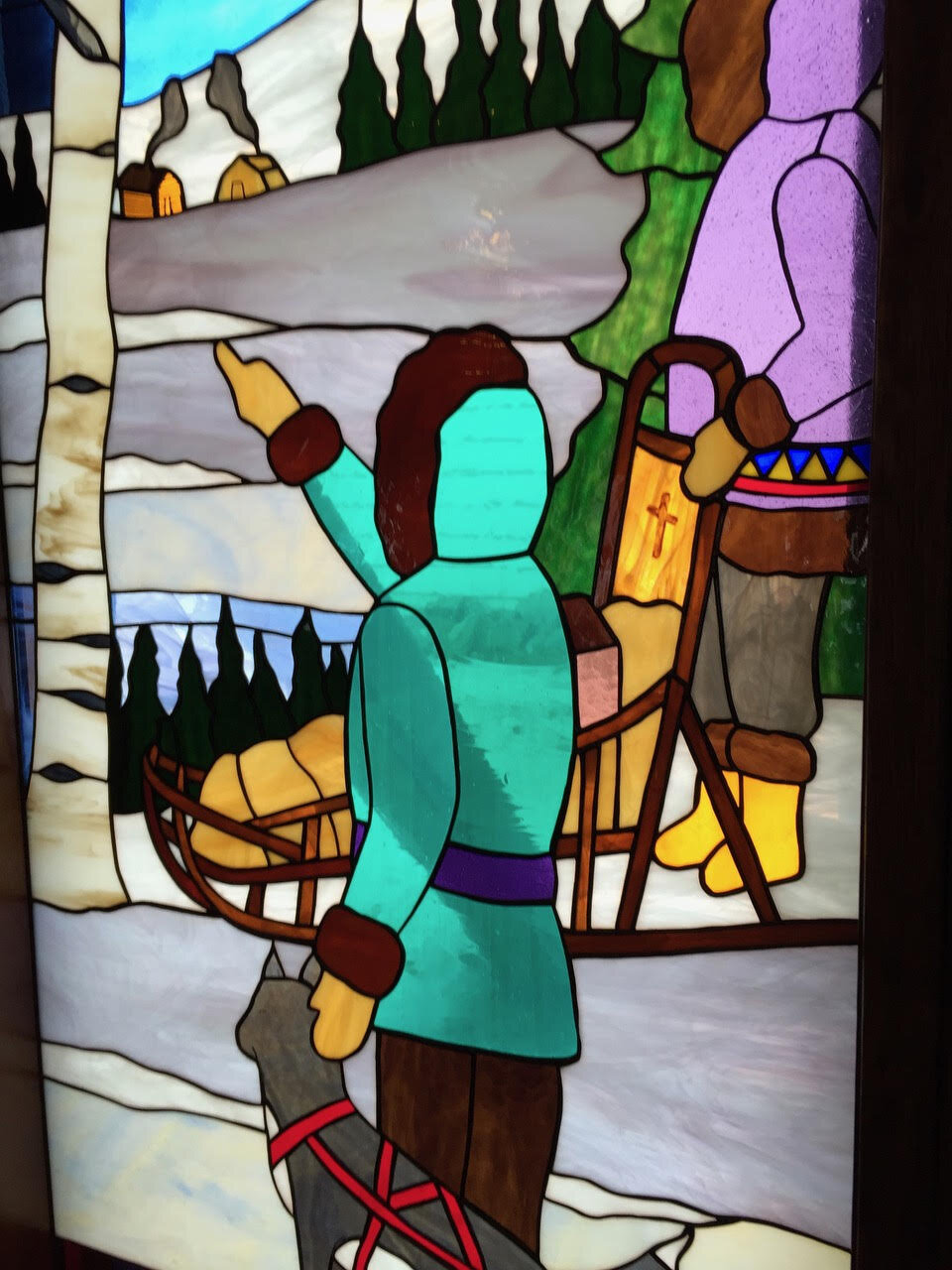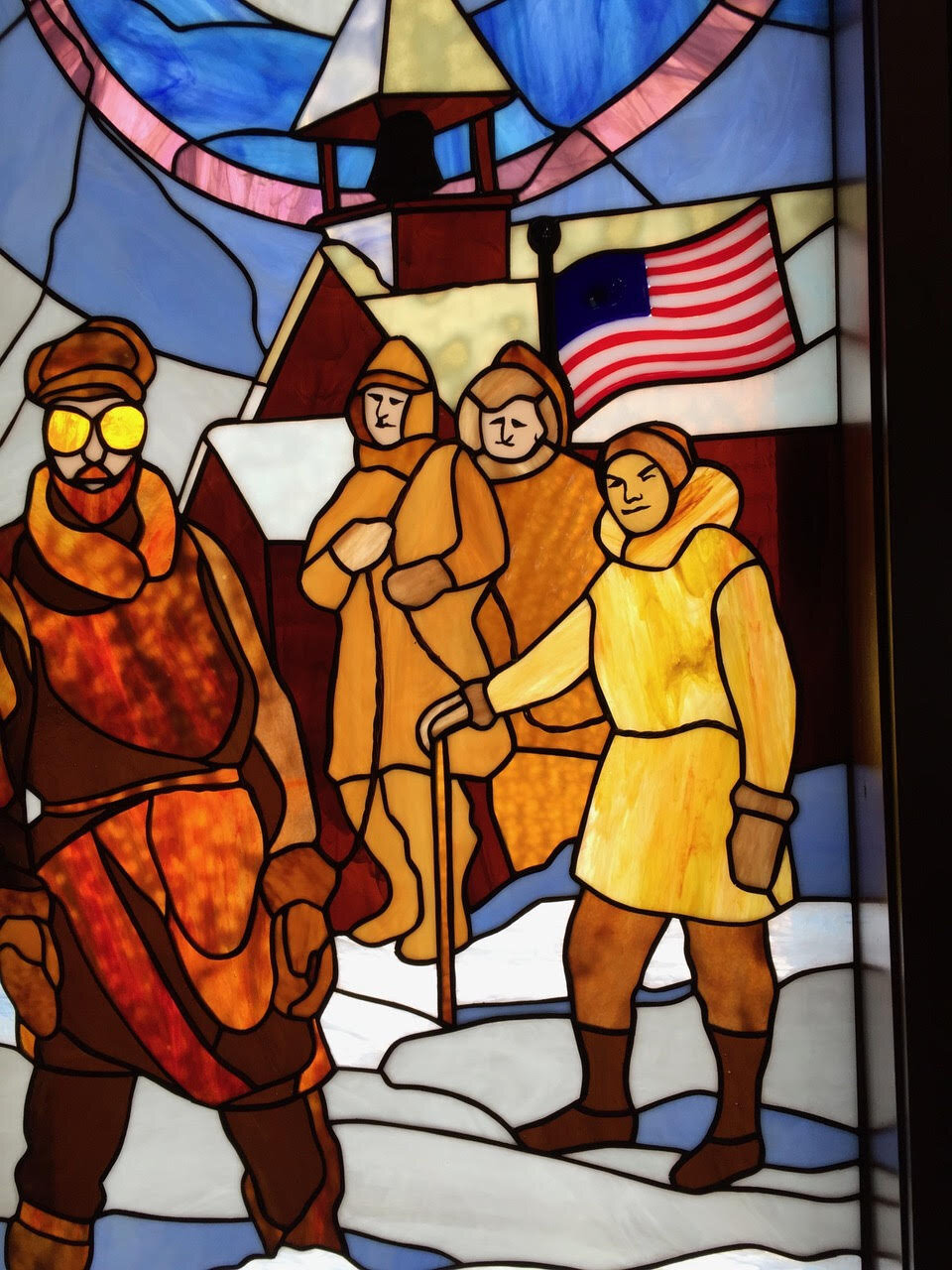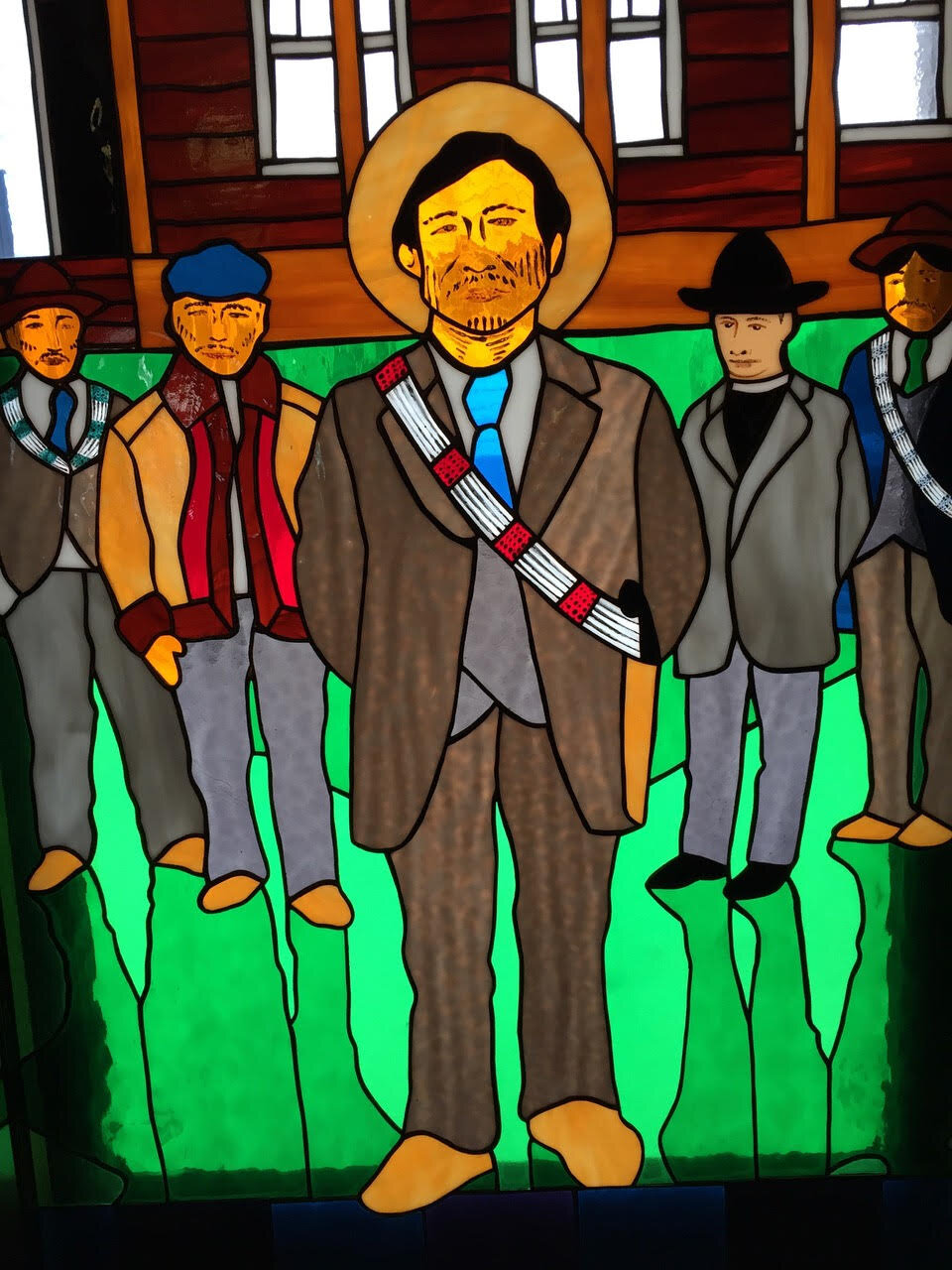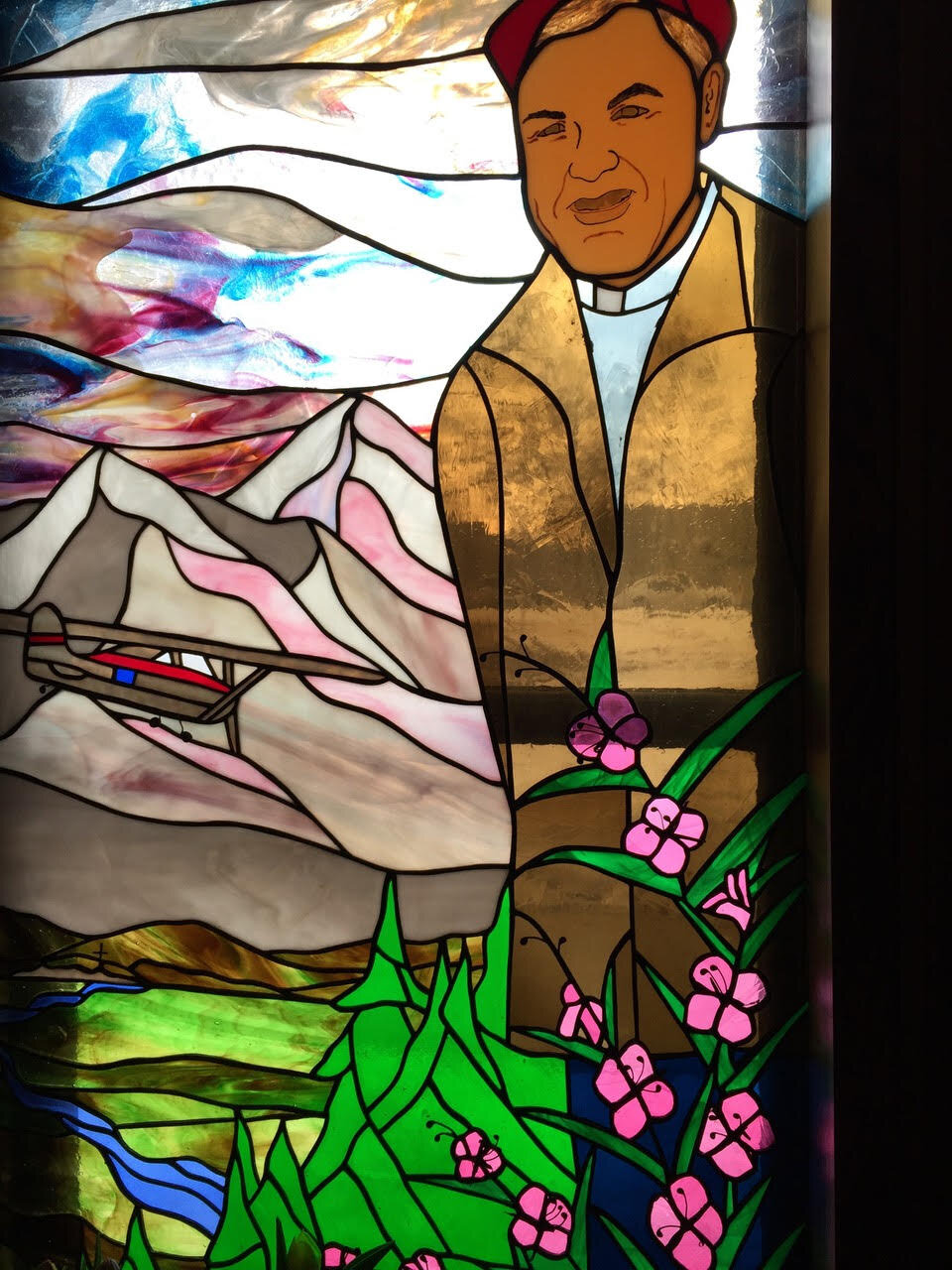How the Episcopal Church is trying to fill Alaska's priest shortage with Natives
FAIRBANKS, Alaska– Upon entering the log cabin church, the first thing one notices is the stained glass.
Not many churches memorialize the major events in their state’s history through stained-glass windows, but the historic St. Matthew’s Episcopal Church on First Avenue overlooking the Chena River in Fairbanks is not a typical church.
Like a movie theater frozen in time, its 12 windows are memorials to events in Alaskan life as they impacted Episcopalians. One window, showing two men in purple and teal parkas on dog sleds, portray the Rev. Charles Rice, a missionary priest in the tiny village of Circle on the Yukon River.
Alongside him is Esais Joseph, his Athabascan guide. The pair are gazing at a new gold mining supply camp on the Chena, where in 1903 Rice was directed to buy some lots for a mission church and a hospital. He also held religious services on Mar. 29 in a local saloon.
A year later, Archdeacon Hudson Stuck, a British-born missionary, moved to town. Having left a comfortable life as dean of St. Matthew’s Episcopal Cathedral in Dallas, he arrived in Fairbanks to oversee the establishment of a log church named after the cathedral he left behind.
Stuck left for missionary endeavors elsewhere in Alaska but was haunted by the presence of Denali, America’s highest and then unconquered peak at 20,310 feet. A second stained-glass window shows Stuck, dressed in copper-brown mountaineering gear in 1913 posing by the church along with a team of three companions before they set out to climb the mountain.
On June 7, the quartet would be the first Americans to summit the peak. Stuck had included Walter Harper, a 19-year-old Native protégé, as part of the team in an effort to build respect for Natives among the white community. Harper was the first of the four men to reach the top.
A third window shows five Athabascan chiefs arriving in Fairbanks for a 1915 meeting with U.S. government representatives, one of whom included an Episcopal priest. The chiefs were concerned with the encroachment of white settlers on their ancestral lands and wanted to maintain unrestricted access to hunting and fishing areas. By now, Fairbanks had become a busy supply center for the gold miners and others wanting to exploit the vast territory.
A fourth window, showing a cleric with an airplane in the background, is the Rt. Rev. William Gordon, Jr., known as the “flying bishop” after he learned to fly a bush plane for his many trips around the Alaska interior from 1948 to 1974.
More than 45 years later, the current bishop, Mark Lattime, is also a licensed pilot who flies to isolated villages in America’s geographically largest diocese at 586,412 square miles. Stretching from Ketchikan in the southeast to Point Lay on the Chukchi Sea, it includes 48 congregations, more than half of them in Native communities reachable only by air, snowmobile or boat.
But the trick is getting Native clergy to preach to that culture. All of the missions are lay-led and Alaska doesn’t have near enough priests willing to work in the state’s isolated churches.
An alternate model is needed to create clergy in the 49th state, where a college diploma, much less a seminary degree is an impossibility for many Alaska Natives.
That’s not to say they’re not spiritually hungry. Two years ago, the little village of Huslia in west-central Alaska — best known as one of the stops during the world-famous Iditarod race — had the fastest growing church in Alaska: Good Shepherd Mission. It had doubled its numbers from 10 to 20. A trio of female licensed worship leaders fueled that growth. Lattime says this team approach works better than simply ordaining one leader, who eventually becomes burned out.
“Right now I’ve got two Native women in the postulancy process,” the bishop says. “One of them I’d ordain tomorrow if she believed she was ready.”
One is Mabel Vent, 70, the main worship leader in Huslia, who says she’s been helping out with the church ever since she was about 18. A former priest left and no one at the church knew how to read the daily lessons.
“An elder came up to me and said, ‘Do you want to read?’” she says. She started as a reader, then took on more tasks to keep the congregation going. Just under 300 people, one-third of them children, live in Huslia, she says, but there’s only two churches in town to serve them. Once the trio of female leaders was able to guarantee regular Sunday services, the church began to grow until the coronavirus pandemic hit earlier this year.
“There are more ladies helping me and we take turns,” she says. “We’ve been doing our own funerals, as last year we had more funerals than baptisms.”
She doesn’t see herself leaving the village to get further theological training.
“In the village, there isn’t money to pay clergy,” she says. “Typically we bring in about $2,000 a year.”
The diocese has 6,357 members on the rolls, but in reality, nowhere near that number are in church on any given Sunday, especially during the summer when many Natives are heading for fish camps to harvest the salmon. Only one church in the diocese, St. Mary’s in Anchorage, has an average Sunday attendance of more than 100.
The diocese has a staff of four, including the bishop. Although it has 40 clergy on the rolls, only 28 of those are assigned to churches; some of them serving more than one community. Only eight are full-time parish priests and the rest are part-time, volunteer, retired or inactive.
Four of the active clergy are Native, among them Trimble Gilbert, a man in his 80s who has served his hometown of Arctic Village for 40 years.
“He wants to retire but the village won’t let him,” the bishop said. “No one wants to follow in his footsteps,” because to plan for a successor would be seen by Natives as disrespectful. Typically when priests retire, they move on to another church in another town. That doesn’t happen in Native villages.
Arctic Village is fortunate to have clergy whereas the bulk of mission churches do not.
“Most of the people in our rural communities have no college experience,” Lattime says. “A bachelor’s degree would seem for many to be a frighteningly insurmountable task.”
Instead, Bishop Lattime says he tries to encourage people who are willing to train to be a worship leader, then maybe a preacher or catechist and only after years, ask them about ordination.
“Then it is not so strange, as it’s where they’ve been moving through all these steps,” he says.
Many rural communities off the road system don’t have WiFi accessibility to do online training programs, so once or twice a year, the diocese brings 10-20 parish leaders to Kotzebue, northwest Alaska, or Fairbanks, for an intensive training program. It’s expensive.
But such gentle coaxing is what’s brought Judy Gau, 57, a Native of Koyukan Athabascan heritage, to the table. She is the second postulant that Lattime would like to ordain.
“The bishop is talking me into doing it, so I think I must just about be ready,” she says. She’s been leading at St. James Episcopal in Tanana, a village on the Yukon River 130 miles west of Fairbanks for the past 20 years and she also started a soup kitchen to feed the homeless and single men. She also does business management for the Alaska Fire Service.
She leads Morning Prayer services at present but, if ordained, she’d have Communion services far more often. The only thing slowing her down is caring for her husband, who is terminally ill with liver cancer.
Although some 300 people live in the vicinity, St. James is lucky to get 12 to 20 people on a good day. She has no idea why more people are not interested. A nearby Catholic church, she says, has the same anemic attendance.
“It’s tough to get people to go to church,” she says, “and we have no young kids around here to get up and go. I am going to do my best to bring everyone together in the church. It’s in my heart to thrive like it used to. When I was a kid, everyone went to church. It was full all the time.”
What changed?
“Alcohol and drugs,” she says. Both are major problems out in the villages. So is suicide, which is at epidemic levels in bush Alaska. Certain solutions, such as flying in visitors to conduct summer vacation Bible schools for the kids, don’t work there, she says, because the village doesn't have the extra housing. Unlike Fairbanks, there aren’t hotels sitting nearby.
She’d like to get more theological training, but a lot of what’s available in terms of courses in the Lower 48 are only offered in the summer. That is the busiest time of year for Natives, who spend weeks at fish camps along the Yukon gathering up a year’s supply of salmon, berries and firewood to last through the frigid winters.
Lattime grasps the difficulties that Native Alaskans have in merely surviving, much less somehow getting a theological education along the way. That is why he longs for a cadre of teachers of the faith from the Lower 48 who’d be willing to spend at least a year in the villages training and raising up lay leaders. Although the diocese doesn’t have the money to pay such people, there is one employer that can: Alaska’s public schools. Despite pay scales averaging $102,000 a year, the state doesn’t have enough teachers in rural areas.
The presence of a corps of Episcopal educators who are certified to work in public schools would go a long way, Lattime says. Plus, the school district provides housing.
“People who’d be willing to come and teach and train and spend time in formation with folks would be great,” he says. “Ideally they’d start near the end of the moose hunting season in mid-August and go to the beginning of the king salmon run in late May.”
Although many Alaskan villages may have more than one church, they started as Episcopal-only villages back in an era when Alaska was portioned into missionary zones. The partitioning idea was birthed by Sheldon Jackson, a tireless Presbyterian missionary who also oversaw Native education for the U.S. government during early-gold rush Alaska. In the mid-1880s, Jackson held a meeting for the representatives of leading Protestant mission boards in Baltimore to parcel out the schooling and evangelization of Alaskan peoples. This was partly to fill a spiritual void left by the departing Russian Orthodox after the territory had been sold to the United States in 1867 and partly to do away with inter-church rivalry so common on other mission fields. (Many Orthodox churches remained open, but they were concentrated on Kodiak Island to the south and the Aleutian islands to the west.)
The Presbyterians got the southeastern panhandle, as they already had a firm foothold there. The Episcopalians got central Alaska, including the Yukon River valley, as the Anglicans across the border had widely used the Yukon to missionize western Canada. Anglican efforts started in 1847 with a mission to the Gwich’in people at the Hudson Bay outpost at Fort Yukon about 145 miles north of Fairbanks. It was in Ft. Yukon that Robert McDonald (the first Protestant missionary to work with the indigenous peoples of the Arctic) produced a Gwich’in translation of the Bible, the Book of Common Prayer and some hymns. Evangelization followed the fur traders among the major waterways that in time led west into Alaska. Simple one-room log cabin churches sprung up in Native communities along the rivers that bisect the enormous state.
The fur trade, the whaling boom off the Arctic coast at the turn of the century and the discovery of gold in 1886 at Fortymile Creek in the far northwestern corner of Canada brought in thousands of prospectors. Along with it came the seeming arrival overnight of western civilization (electricity, telephones, hotels and theater) to the region.
This was also a time of crisis for the Natives, who were seeing American ships kill off their bowhead whale and walrus population and who were being hit with infectious diseases first brought in by the Russians. When missionaries began arriving by 1890, the decimated Native population was looking for answers. A consortium of Congregationalist, Episcopalian and Presbyterian missionaries brought medical treatment and basic schooling (math, industrial arts and reading, writing and speaking English) to the Inupiats in Arctic Alaska by 1897.
Within two decades, much of the territory had converted from shamanistic beliefs, with much of the heavy lifting done by Native evangelists. As Stuck himself noted in 1920, there were at that point “no unbaptized natives left in Alaska.”
Sometimes, more conservative Protestant groups that were assigned pieces of Alaska to evangelize forbade any enculturation whatsoever. One result of this was the Inupiat who, to this day, will not bring their graceful dances into church.
“One of the things the Episcopal Church is very good about here is honoring and respecting Native tradition and culture and wanting the church to reflect that,” Lattime says. “But the elders were convinced by some missionaries that dancing was inappropriate. Even as bishop, when I tell them I’d like to see it happen, there is this resistance.”
Institutionally, the Episcopal Church is looking to train more Indigenous leaders for ministry. The Rev. Dr. Mary Frances Crist, the Episcopal Church’s new coordinator for Indigenous theological education, is a member of the Blackfeet Nation, which is located in northern Montana. She is working to make theological education more available to Episcopalians in heavily Indigenous dioceses (which also include North and South Dakota) by integrating Native history and traditions into theology courses.
She is part of preliminary conversations with Sitting Bull College, a tribal institution in Fort Yates, North Dakota, to design undergraduate programming in applied theology and with Bexley-Seabury Theological Seminary in Chicago to establish graduate-level courses. Seabury Divinity School has been working with Indigenous people since 1860. The goal is a theological education that fits people who hold both Christian and traditional tribal world views.
Over a 13-year period, she has visited Alaska multiple times and come to appreciate firsthand how reluctant Indigenous parish leaders were to leave their homes for theological education. Family ties make it difficult for them to be gone for months at a time and the churches they lead depend on them.
“The Native people of Alaska have kept those village churches going for decades,” she says. “The only time they get clergy is when the bishop flies in for Confirmation or volunteer clergy come in.”
It is for these people that she would like to put together a study program whereby lay leaders can stay put. It was out of concern for rural congregations that General Convention established Crist’s position and one of her responsibilities is to help bishops set up study programs for lay leaders and those seeking ordination. Traditionally, a candidate must earn a seminary degree and pass the General Ordination Exams to be ordained. However, Canon 4 of the Episcopal Church allows each diocese to license communicants to be eucharistic ministers and visitors, preachers, pastors, worship leaders, evangelists and catechists.
For those who move on to get ordained, they’ll end ministering in the villages as volunteers. In fact, a majority of the diocesan clergy don’t get a salary, Lattime says.
“Annual giving is in the 10s or 100s of dollars,” he explains. “Most of the money goes toward keeping the heat and lights on.” He aims to partner with congregations to provide clergy a small stipend once a month. For those without clergy, he tells them that church isn’t only when the bishop or a guest clergy person flies in.
“A good year is getting Holy Communion six times a year and with some churches, it is less than that,” he says. “I try to emphasize the church isn’t all about celebrating Holy Communion but in creating disciples who will do the work of the church and be there all the time.”
Julia Duin is a veteran journalist who has worked as an editor or reporter for five newspapers, has published six books and has master’s degrees in journalism and religion. She currently freelances out of Seattle for the Seattle Times, Washington Post and other outlets.




